Hi! It’s review season again! Theros Beyond Death has arrived and offers us new toys for cube owners and i’m excited to get into it with you.
First, and as advertized, Sagas are back. Sagas play out well, their countdown mini-games excellent designs for limited. Of the new ones here in Theros, there are a few that have exceeded my expectations after some testing.
We also have a fistful of new enchantment gods, remixed from their original incarnations. And perhaps the most important of all is Escape, which has proven itself far above even my highest expectations. As it turns out, spells you can cast over and over again—even with some restrictions—can feel broken.
Then there’s constellation, or Enchantment-matters. This is, relatively, the parasitic mechanic of the set. Most of these cards won’t make it into our cubes without a serious commitment to supporting the archetype. Therefore, i’ll only be touching on cards which hold an inherent power level and don’t rely too much on synergy. However, it’s possible that Theros Beyond Death has opened up the possibility of an Enchantment-Matters archetype in rarity restricted cubes.
I won’t be giving out letter grades, but I’ll rate my top cards at the end of each article. We’ll go in WUBRG color order, then Multicolor and Colorless.
Check out our previous reviews of White, Blue, and Black.
Without further ado!
Purphoros, Bronze-Blooded
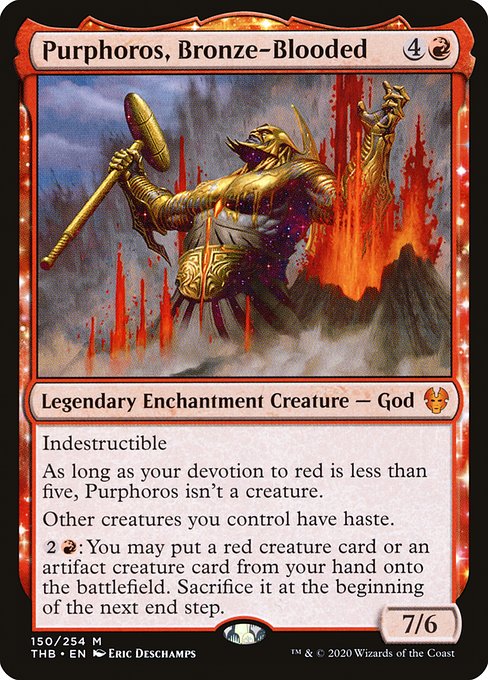
Sneak Attack is a long beloved card for most combo-centric, powered and nearly powered cube environments. With the printing of Through the Breach cube designers were given a glimmer of redundancy to the archetype, and Purphoros, Bronze-Blooded‘s spoiling teased us as yet another potential enabler. However, I haven’t even thought about testing this card because . . . well . . . it sucks. It doesn’t take much to see that Purphoros can’t meaningfully contribute to the Cheating McFattys into Play archetype, nor is it even worth its place anywhere else.
Paying five mana for half of Hammer of Purphoros—an enchantment that gives all our creatures haste—is barely worth a card. Actually, it’s not worth even half a card. Anything this expensive needs to be seriously impacting the battlefield, so even if—and we’re talking best case scenario here—you already have four red pips and Purphoros can enter the battlefield as a creautre, he doesn’t even have haste!
And if you can somehow stomach this big, awkward, fumbling enchantment, his activated ability is just too expensive and restrictive; limited only to Red and Artifact creatures. Isn’t the whole point of cheating creatures into play—to CHEAT on mana? If I can’t plop down Griselbrand or Emrakul, the Aeon’s Torn then what I am even doing here?
How on Earth am I incentivized to try Purphoros when he isn’t even good at being parasitic? This is a hard pass for me.
The Akroan War
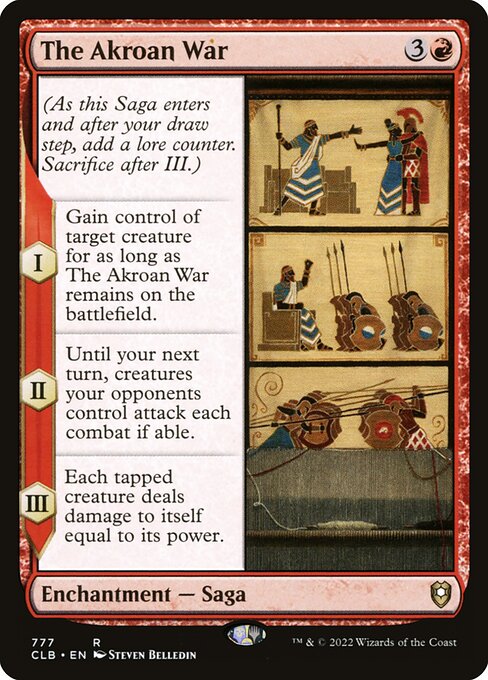
While a promsing card for most creature-centric cube environments, the wide-reaching function of The Akroan War still leaves something to be desired. With some testing I found War to be too narrow for most of my Red decks and was often relegating it to a situationally powerful sideboard card.
Chapter I’s Control Magic is the big draw to playing War. When ahead, playing this saga can win you the game, but i’d argue that most cards which do basically anything will win the game when you’re already ahead: the most useless evaluation of a card is how it performs when you’re winning. Don’t concern yourself with that. Rather, look to board parity or when losing to get a better sense of the cards average case performance.
A temporary Control Magic will shine when the matchup is heavily dictated by creature combat. It’ll be a two for one most of the time, which is very good. You take their best creature, then force them to attack into it and trade or use a removal spell. Chapter II will help win a race or force bad attacks. Chapter III has a high amount of variance, ranging from Plague Wind all the way down to a blank, nothing. It’s inconsistent, swingy, and great for cube campfire stories.
My main issue with The Akroan War is I have no idea what deck actually want this. My Red aggressive decks tend to top out at four, and these top end slots are precious. My control decks don’t want to tap out for something that doesn’t guarantee to catch them up. So it’s a midrange card? At this point, wouldn’t you rather have another planeswalker or another removal spell? You know, something more consistent?
Ox of Agonas
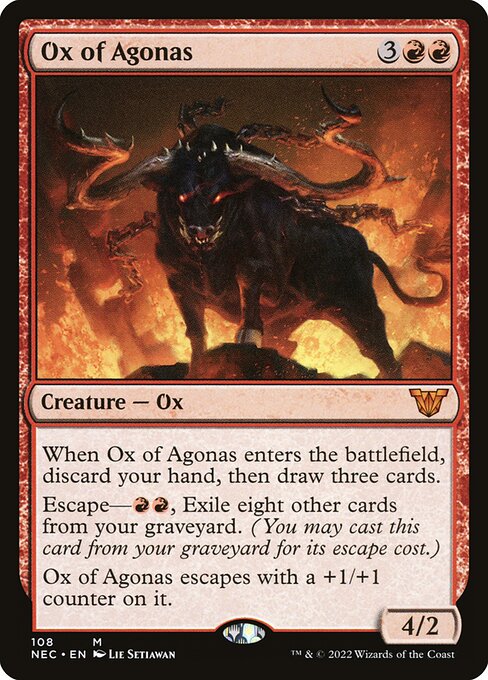
Ox of Agonas promises a lot of value. Red has a fistful of stellar five drops already: Zealous Conscripts, Glorybringer, Kiki-Jiki, Mirror Breaker, Thundermaw Hellkite, and Siege-Gang Commander. What does the Ox do for us that the others can’t? Ox is a value creature at heart, it’s closest relative being Siege-Gang Commander. They both give us a lot of value for our mana, and can help close out a game. Not immediately, but imminently over the next few turns. This is good, especially when curving out, but doesn’t quite slam shut the door like the other five drop creatures do.
This lack of punch is my big issue with Ox of Agonas. Sure, drawing three cards is awesome, but so is ending the game.
The Escape mechanic here is deceptive, something i’m valuing in Constructed formats rather than cube. Exiling eight cards is absurdly unreliable, unless you plan on running Ox in a Wildfire-style deck with mana rocks and land destruction. If you can get to eight cards in the yard playing Mono Red and the game still isn’t decided, then I hope the Ox coming back will finish the game. Send me that screenshot.
Purphoros’s Intervention
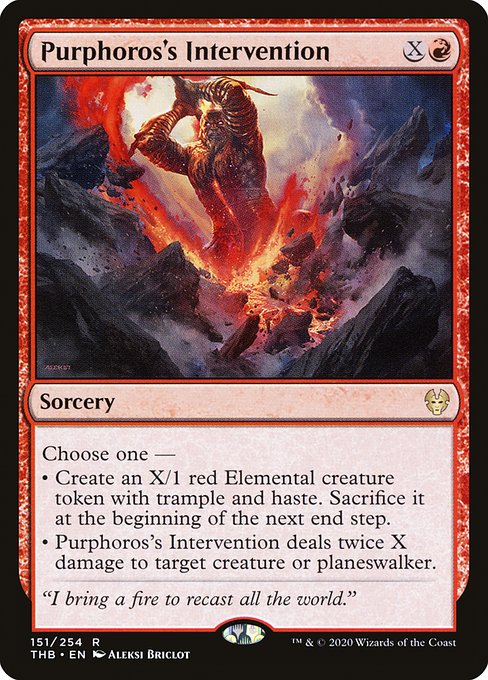
Purphoros’s Intervention is the first Red card that excites me. As I’ve stressed in these reviews flexibility is king; this Intervention is not only flexible, but the most impactful of the entire cycle for cube. As a removal spell Intervention scales with the game, and because of the “Fireball on Legs” mode is never truly a dead draw. It kills the problem, and sometimes even the opponent if the game goes late enough.
Purphoros’s Intervention plays well even outside of heavy Red decks. It plays in midrange and control decks too, and the casting cost means it can easily be splashed. If you can make enough mana it’s also a one-card win condition, so don’t be afraid to use it alongside Thousand-Year Storm or any Palinchron-fueled shenanigans. This card continues to impress me the more I cast it, and is a solid inclusion for most cubes.
Phoenix of Ash
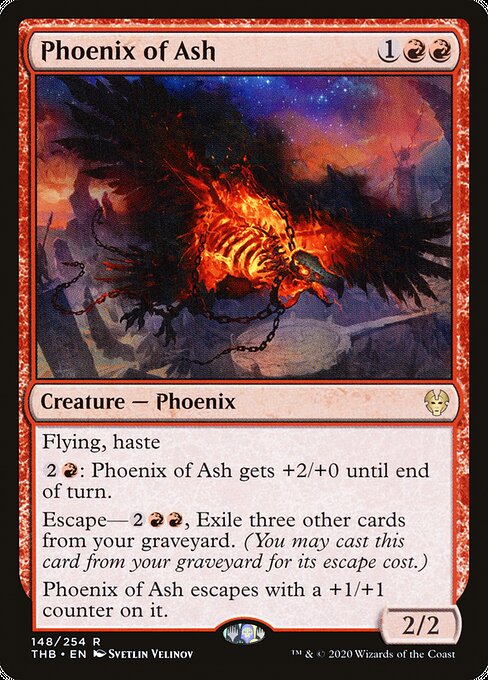
It shouldn’t be a surprise Phoenix of Ash is excellent. We used to play Chandra’s Phoenix before the printing of multiple variants on Goblin Rabblemaster, when red struggled to put meaningful pressure down on three. The bar is much higher now in 2020, and Pheonix of Ash is absolutely on par with whats expected from our Red threats.
Phoenix has everything I want in a creature: evasion, a mana sink, efficient recursion. Escaping for only three cards means it will potentially come back multiple times per game, and Phoenix can always play defensively, to block and trade in a pinch. Phoenix is perfectly suited to Izzet decks capable of digging deep into their libraries, but it’s felt great in Red and Rakdos too, where discard or sacrificing creatures for value can be a piece of the overall puzzle.
Phoenix of Ash doesn’t need much else to be great. Just play your game and you’ll be impressed.
Storm’s Wrath

Cubes looking to max out on sweepers might be interested in Storm’s Wrath. It’s unique, hitting both creatures and planeswalkers, which is certainly the pull for including the card. It’s been best for me in controlling Izzet decks. Yes, the planeswalker damage is certainly a liability, especially in combination with Blue, but you should be able to navigate your boardstates and mitigate the splash damage.
Not every cube likes having Red sweepers. I do, and Storm’s Wrath has been handy in both control mirros and aggro mirrors. If you have a bigger cube, or you’d simply like to max out on redundancy for red sweepers, Storm’s Wrath is positioned at a desirable casting cost for it’s effect.
Underworld Breach

Do you like Rube Goldberg machines?
The hype surrounding this card is as crazy as the audacity Wizards had to design it. It’s unbelievable they’d print an arguably better version of Yawgmoth’s Will. If you told us this a year ago we’d probably laugh or shun you off the stage. Yet here we are. It’s 2020 and it’s a whole new world.
That said the only place I believe this card is necessary is in combo-focused cubes like the MTGO Vintage cube. There the redundancy is welcome, as—let’s face it—storm players need all the help they can get. I’m not advocating for this card anywhere else, but it’ll certainly start getting abused as soon as it’s available to draft online. What a ridiculous feast of nonsense.
Anax, Hardened in the Forge
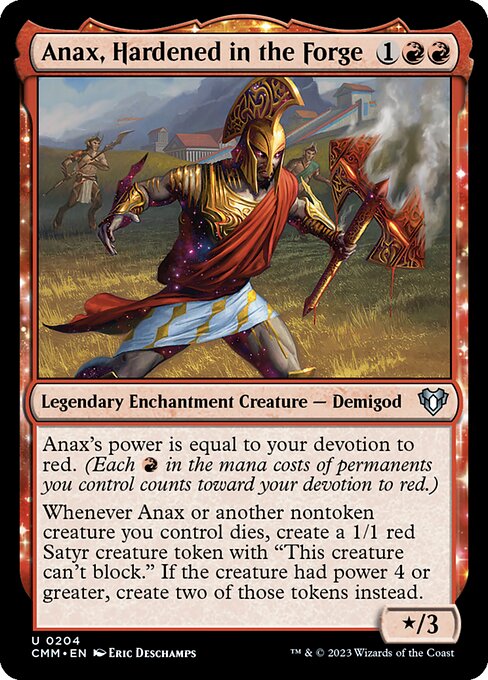
There’s been a lot of questions asked since Anax was printed on where, exactly, he best fits in cube. I think a lot of designers are looking at Anax with rose-colored glasses. There’s really not much going on here that’s better than what we already have at the three drop slot. Red creatures want value going in or as they continue to put on pressure. Anax is a God of a different color, promising value going out—i.e. death triggers—and comboing with other sacrifice strategies. I think this promise holds, but I wouldn’t recommend it outside of a rarity restricted environment.
Anax is a crucial piece of a complicated, critical mass archetype that requires a lot of design space. Inherently it’s just not that powerful a card except, specifically, against wraths. But Phoenix of Ash is just as valuable there, and does a much better job at winning the game.
Careless Celebrant
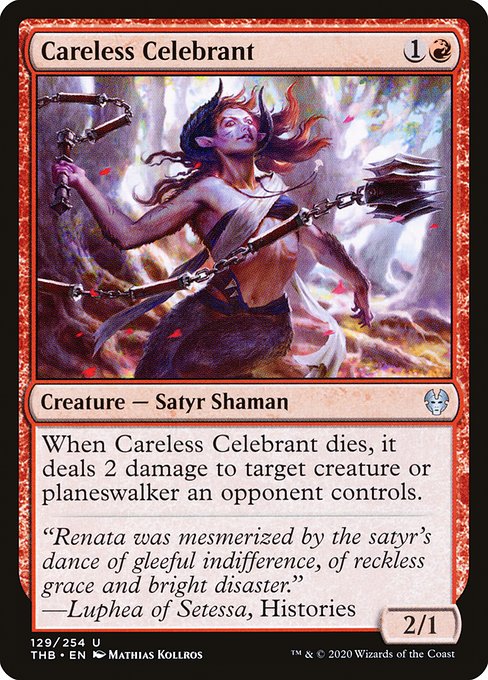
Careless Celebrant is a cute little value two drop that has decent, if unexciting functionality. The card is good in cheap aggrressive decks and fine as a sideboard card for midrange or control. If you like to sacrifice your creatures for value, Careless Celebrant comes with that bit of extra business. It’s nothing special, a replacement level aggressive card perfect for rarity restricted cubes and large cubes craving redundancy.
Furious Rise
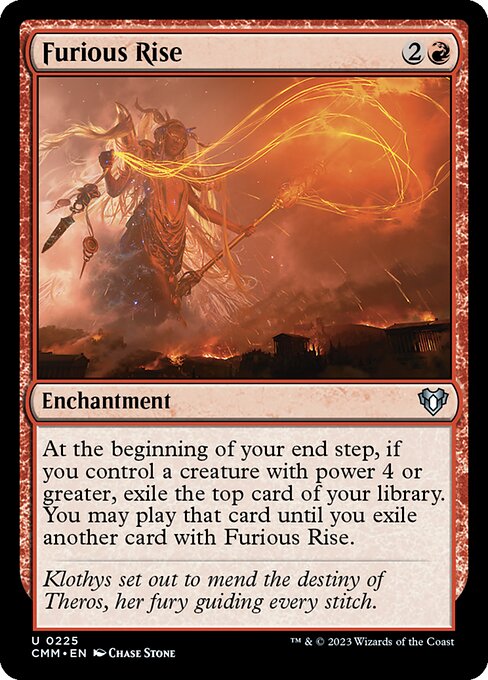
Furious Rise reminds me of Elemental Bond or Colossal Majesty, except it’s more Red in its design execution. These enchantments are fun build arounds in rarity restricted cubes and,;while Furious Rise feels like more like a Green card, I think you can support it well enough in Red heavy decks with some tweaking to your creature base. Anytime Red is given a chance to accrue card advantage I think it’s worth looking looking into.
Satyr’s Cunning
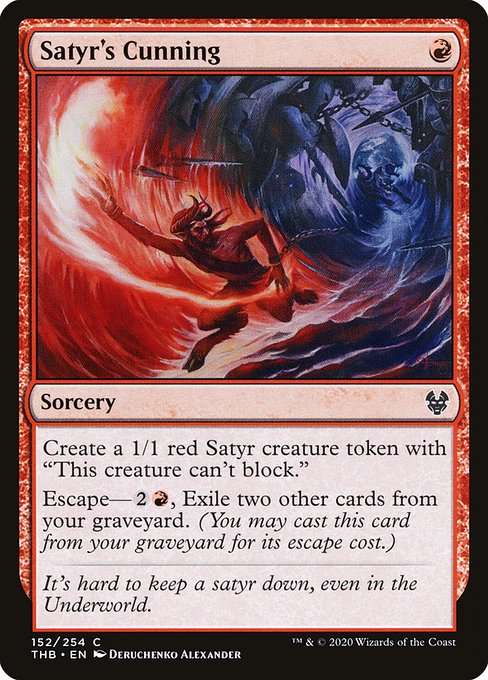
I’ve seen some talk about this card being a good recursive one drop for Mono Red, and i’m not sure I agree. Neither the front or back half of this card is appealing to me. How aggressive do you have to be for a 1/1 that can’t block to be worth a card? Or paying four mana for two 1/1’s? I don’t think the investment is worth the output here, even considering it affects spells matters cards like Kiln Fiend or Young Pyromancer. If you have a big cube with a low power level this can be a puzzle piece for a few archetypes, but I think we have better options available to us.
Underworld Rage-Hound
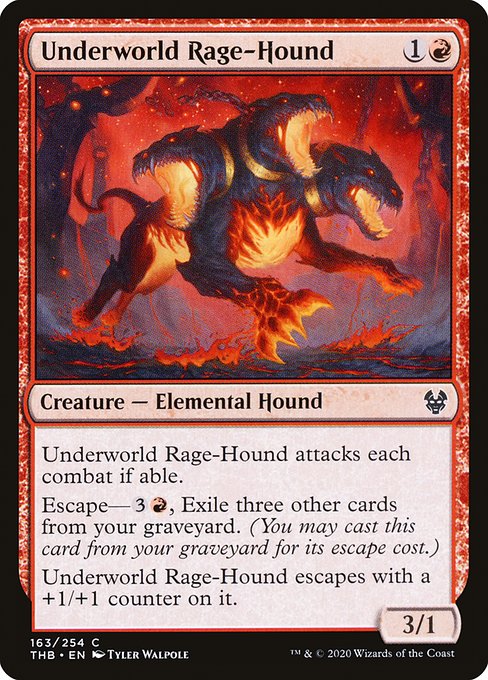
I thought Underworld Rage-Hound would be a slam dunk for my cube. After only a few test runs, where it failed to be the Red Scrapheap Scounger, I was left feeling more disappointed by this card than any other card in the set. That it must attack every turn is the cards big weakness, one which seemed to trump all of the cards perceived advantages. Underworld Rage-Hound is best suited in a Pauper or Peasant cube, or in a 720+ needing to fill in its creature curve slots.
Power Rankings—Red
Legacy/Powered
Peasant/Pauper
Red gets its biggest boost at higher power levels, with only one unique inclusion for rarity restricted cards. This is below the curve for Peasant and Pauper in my opinion. I’m very excited about Phoenix and Intervention, and I hope you give them both a try if you haven’t already.
Next week we finish up the colors with Green, then we bring it to a close with Multicolor and Colorless cards. Thanks for reading!

